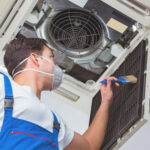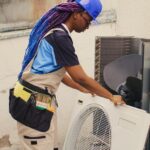
How to Reduce Allergens in Your Home with HVAC
How to Reduce Allergens in Your Home with HVAC
Allergens lurk in the corners of our homes, invisible yet impactful. From pesky pollen to dander from our beloved pets, these microscopic troublemakers can wreak havoc on our respiratory systems, triggering allergies and exacerbating asthma. However, there’s hope in the form of your trusty HVAC system. In this guide, we’ll explore effective strategies to combat allergens within your home using your heating, ventilation, and air conditioning system. Say goodbye to sneezing fits and red eyes as we delve into the realm of allergen reduction with HVAC mastery.
Understanding Allergens
Allergens, typically microscopic substances, provoke allergic reactions in susceptible individuals. Sources vary, ranging from pollen and dust mites to mold spores, pet dander, and specific foods. Upon entry into the body, the immune system misidentifies these allergens as threats, prompting the release of histamines and other chemicals, resulting in symptoms like sneezing, itching, and congestion.
Understanding the types and origins of allergens in your surroundings is vital for implementing effective reduction strategies. By identifying and addressing these triggers, individuals can significantly alleviate allergic symptoms and enhance their overall quality of life.
The Invisible Threat: Allergens in Your Home
Though imperceptible to the naked eye, allergens saturate our homes, nesting in carpets, upholstery, bedding, and the very air we breathe. Pollen infiltrates through open windows, while pet dander clings to furniture, and dust mites thrive in warm, humid settings. Mold spores lurk in moist corners like bathrooms and basements.
These unseen allergens pose significant health risks, provoking allergic reactions and worsening respiratory ailments such as asthma. Recognizing and mitigating these concealed triggers is imperative for fostering a healthier indoor environment for both you and your family, ensuring comfort and well-being within the sanctuary of your home.
The Impact of Allergens on Health
Allergens aren’t just nuisances; they can have a significant impact on our health. For allergy sufferers, exposure to allergens can lead to uncomfortable symptoms like sneezing, coughing, wheezing, and skin rashes. In more severe cases, allergens can trigger asthma attacks, which can be life-threatening. Prolonged exposure to allergens may also contribute to the development of chronic respiratory conditions and worsen existing ones.
Additionally, allergies can have a negative impact on quality of life, affecting sleep, productivity, and overall well-being. Recognizing the health implications of allergens underscores the importance of taking proactive measures to reduce them in our indoor environments.
Harnessing the Power of HVAC Systems
Your HVAC (Heating, Ventilation, and Air Conditioning) system is more than just a means to regulate indoor temperature; it’s a powerful tool for allergen reduction. By properly maintaining and optimizing your HVAC system, you can effectively filter out and remove allergens from your home’s air supply. High-efficiency air filters can capture airborne particles like pollen, dust, pet dander, and mold spores, preventing them from circulating throughout your living spaces.
Additionally, advanced HVAC technologies, such as UV germicidal lights and air purifiers, can neutralize allergens and improve indoor air quality further. Harnessing the power of your HVAC system is key to creating a healthier and more comfortable home environment for you and your family.
Introduction to HVAC Allergen Reduction
Welcome to the world of HVAC allergen reduction, where science meets comfort to create healthier indoor environments. In this section, we’ll embark on a journey to explore the role of your heating, ventilation, and air conditioning (HVAC) system in combating allergens.
From understanding the mechanisms of allergen filtration to implementing effective strategies, we’ll equip you with the knowledge and tools necessary to breathe easier at home. Say goodbye to sneezing fits and allergy flare-ups as we uncover the secrets of HVAC allergen reduction.
Pollen, Pet Dander, and More: Identifying Allergens
Allergens come in many shapes and sizes, each with its own unique set of challenges. Pollen from trees, grasses, and weeds can infiltrate your home through open windows and doors, triggering seasonal allergies. Pet dander, consisting of tiny flecks of skin shed by furry companions, can linger in the air and on surfaces, causing allergic reactions in susceptible individuals.
Dust mites, microscopic arachnids that thrive in bedding and upholstery, are another common allergen culprit. By learning to identify these and other allergens, you can take proactive steps to minimize their presence and create a healthier living environment for you and your loved ones.
HVAC Filters: Your First Line of Defense
When it comes to combating allergens in your home, HVAC filters are your first line of defense. These specialized filters work tirelessly to capture and trap airborne particles, including pollen, dust, pet dander, and mold spores, preventing them from circulating throughout your living spaces.
By regularly replacing or cleaning your HVAC filters, you can ensure that they remain effective in removing allergens and maintaining good indoor air quality. With a clean and properly maintained filter, you can breathe easier and enjoy a healthier home environment for you and your family.
Ventilation Strategies for Allergen Control
Proper ventilation is essential for controlling allergens in your home and maintaining good indoor air quality. By promoting airflow and reducing humidity levels, ventilation strategies can help prevent the buildup of allergens like mold and dust mites. Opening windows and doors to allow fresh air to circulate can help flush out indoor pollutants and allergens, while exhaust fans in kitchens and bathrooms can remove moisture and prevent mold growth.
Additionally, investing in a whole-house ventilation system can ensure consistent airflow throughout your home, reducing the concentration of allergens in the air. By implementing effective ventilation strategies, you can minimize allergen exposure and create a healthier living environment for you and your loved ones.
Maintaining Optimal Indoor Air Quality
Achieving and maintaining optimal indoor air quality is essential for a healthy home environment, particularly for allergy sufferers. Indoor air quality can be affected by various factors, including pollutants, allergens, and humidity levels. To ensure that your home’s air is clean and healthy, it’s essential to implement regular maintenance practices and invest in air quality improvement solutions.
From cleaning and replacing HVAC filters to controlling humidity levels and minimizing indoor pollutants, there are several steps you can take to maintain optimal indoor air quality and promote better health and well-being for you and your family.
Advanced HVAC Technologies for Allergen Removal
In the quest for cleaner indoor air, advanced HVAC technologies play a crucial role in allergen removal and air purification. These innovative technologies go beyond traditional filtration methods to target and eliminate allergens more effectively. UV germicidal lights, for example, use ultraviolet radiation to neutralize airborne pathogens like bacteria, viruses, and mold spores, reducing the risk of allergic reactions and respiratory infections.
Similarly, air purifiers equipped with HEPA filters can capture and remove even the smallest allergen particles from the air, providing relief for allergy sufferers. By incorporating advanced HVAC technologies into your home’s heating and cooling system, you can enjoy cleaner, healthier air and a more comfortable living environment.
Tips for Allergen Reduction
Reducing allergens in your home doesn’t have to be a daunting task. With a few simple tips and tricks, you can create a healthier living environment for you and your family. Start by regularly cleaning and vacuuming your home to remove dust, pet dander, and other allergens from surfaces and carpets. Wash bedding and curtains in hot water weekly to eliminate dust mites.
Invest in hypoallergenic pillow and mattress covers to protect against allergens. Additionally, consider using a high-efficiency air purifier and upgrading to allergen-reducing HVAC filters. By implementing these tips, you can significantly reduce allergen exposure and enjoy a more comfortable home environment.
Professional HVAC Services for Allergy Sufferers
For allergy sufferers, professional HVAC services can be a game-changer in the battle against allergens. HVAC technicians can assess your home’s heating, ventilation, and air conditioning system to identify potential allergen sources and recommend solutions for improvement. From upgrading to high-efficiency air filters to installing UV germicidal lights and air purifiers, professional HVAC services can help create a cleaner and healthier indoor environment.
Additionally, routine maintenance and inspections can ensure that your HVAC system is operating efficiently, further reducing allergen exposure. By enlisting the help of experienced HVAC professionals, allergy sufferers can breathe easier and enjoy greater comfort and peace of mind at home.
Enjoying a Breath of Fresh Air: Allergen-Free Homes
Imagine coming home to a space where the air is crisp, clean, and free of allergens. With a few simple changes and investments, you can turn this dream into a reality. Start by implementing allergen reduction strategies like regular cleaning, washing bedding, and using air purifiers and high-efficiency HVAC filters. Consider upgrading to advanced HVAC technologies like UV germicidal lights for added allergen protection.
Additionally, scheduling professional HVAC services can ensure that your system is operating at its best and minimizing allergen exposure. By taking these steps, you can create an allergen-free oasis where you can breathe deeply and enjoy a healthier, more comfortable home environment.
Combating allergens in your home is not just about comfort; it’s about safeguarding your family’s health and well-being. With the right knowledge and tools, such as your HVAC system, you can significantly reduce allergen levels and create a healthier indoor environment.
Whether it’s upgrading to high-efficiency filters or investing in advanced HVAC technologies, every step you take brings you closer to an allergen-free home. For professional assistance and expert advice on optimizing your HVAC system for allergen reduction, contact Cool Factory, Inc. at (703) 713-5113. Located in Sterling, VA, we’re here to help you breathe easier and live healthier.






